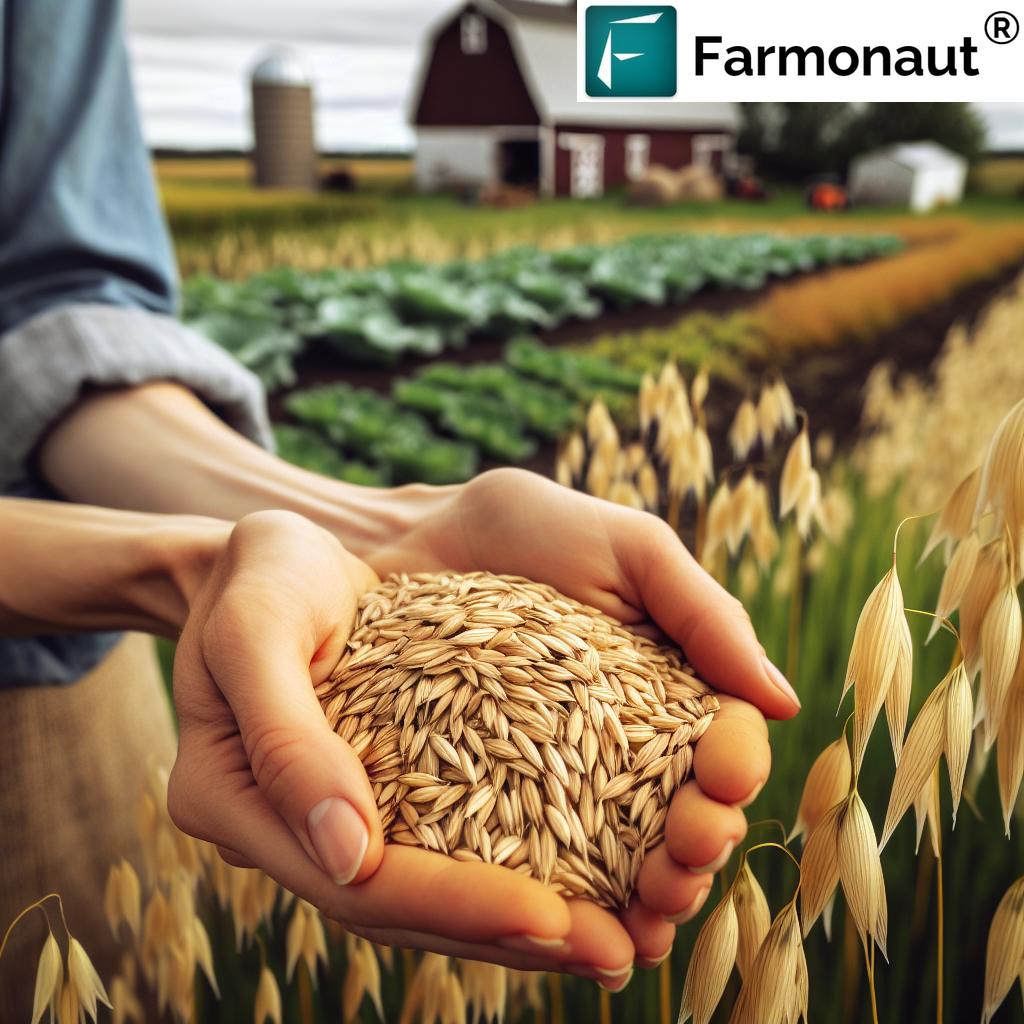Ultimate Guide: Cultivating Oats for Small Farms in Canada – Boost Soil Health and Sustainability

“Oats can be planted at a depth of 1-2 inches, promoting optimal germination and root development for small farm cultivation.”
Welcome to our comprehensive guide on small farm oat cultivation in Canada! As experts in sustainable farming practices, we at Farmonaut are excited to share our knowledge on growing oats for soil health and maximizing productivity on your small farm. In this blog post, we’ll explore the numerous benefits of cultivating oats (Avena sativa) and provide you with essential oat planting techniques to ensure success.
Why Choose Oats for Your Small Farm?
Oats are an excellent choice for small-scale grain production due to their versatility and numerous advantages:
- Soil health improvement
- Erosion prevention
- Increased organic matter in soil
- Adaptability to various climates
- Potential for multiple uses (human consumption, livestock feed, green manure)
Let’s dive deeper into these benefits and explore how oats can revolutionize your small farm operations.
The Soil Health Champion: Oats
One of the primary reasons we recommend oats for small farms is their remarkable ability to improve soil health. As a cover crop, oats excel at:
- Preventing soil erosion: The extensive root system of oats helps hold soil particles together, reducing the risk of erosion caused by wind and water.
- Enhancing soil structure: Oat roots create channels in the soil, improving aeration and water infiltration.
- Increasing organic matter: When incorporated into the soil, oat residues decompose, adding valuable organic matter and nutrients.
- Suppressing weeds: Oats grow quickly, outcompeting many weeds and reducing the need for herbicides.
By integrating oats into your crop rotation, you’re not just growing a valuable grain – you’re investing in the long-term health and productivity of your soil.
Best Time to Plant Oats in Canada
Timing is crucial when it comes to oat planting techniques. In Canada, we recommend two main planting seasons:
- Spring planting: Ideal for grain production, typically done in early spring as soon as the soil can be worked.
- Late summer planting: Perfect for cover cropping and soil improvement, usually in August.
Late summer planting offers unique advantages for small farms:
- Natural soil preparation for the following spring
- Erosion control during fall and winter
- Opportunity for green manure before winter freeze
Tip: Use Farmonaut’s  to monitor soil conditions and weather patterns for optimal planting timing.
to monitor soil conditions and weather patterns for optimal planting timing.
Oat Cultivation Guide for Small Farms in Canada
| Cultivation Aspect | Recommendation | Benefits | Challenges | Tips |
|---|---|---|---|---|
| Planting Time | Late summer (August) | Natural soil preparation, erosion control | Weather unpredictability | Monitor soil moisture levels |
| Sowing Technique | Broadcast or drill seeding | Even distribution, efficient planting | Equipment availability | Adjust seeding rate based on method |
| Soil Preparation | Minimal tillage | Preserves soil structure, reduces erosion | Weed management | Use cover crops or mulch for weed suppression |
| Crop Rotation | Rotate with legumes or brassicas | Improves soil fertility, breaks pest cycles | Planning complexity | Keep detailed records for optimal rotation |
Optimal Sowing Techniques for Oats
When it comes to oat planting techniques, we recommend two primary methods:
- Broadcast seeding: Ideal for small areas or when incorporating oats as a cover crop.
- Drill seeding: More precise and efficient for larger areas or when planting for grain production.
Regardless of the method, follow these key principles:
- Plant oats at a depth of 1-2 inches for optimal germination.
- Ensure good seed-to-soil contact to promote even emergence.
- Adjust seeding rates based on your goals (higher for cover cropping, lower for grain production).
Pro tip: Use Farmonaut’s satellite-based crop monitoring to track your oat field’s progress and health throughout the growing season. 
Integrating Oats into Crop Rotation Systems
Oat crop rotation is a powerful tool for small farms to improve soil health and break pest cycles. Here’s how to effectively integrate oats into your rotation:
- Follow oats with legumes like peas or soybeans to fix nitrogen in the soil.
- Use oats as a nurse crop for establishing perennial forages.
- Plant oats after heavy feeders like corn to help restore soil nutrients.
- Incorporate oats as a winter cover crop between main cash crops.
By strategically placing oats in your rotation, you’ll maximize the benefits of oats for farmers while promoting overall farm sustainability.
“Summer-planted oats can produce up to 2 tons of organic matter per acre, significantly enhancing soil health and fertility.”
Advantages of Summer-Planted Oats
While spring-planted oats are common for grain production, summer-planted oats offer unique benefits for small farms:
- Natural soil preparation: Oats’ extensive root system helps break up compacted soil.
- Erosion prevention: A dense oat cover protects soil from fall and winter erosion.
- Weed suppression: Rapid growth outcompetes many weeds, reducing herbicide needs.
- Nutrient capture: Oats scavenge excess nutrients, preventing leaching and improving soil fertility.
Summer-planted oats are particularly effective at preventing soil erosion with oats, making them an excellent choice for sustainable farming practices.
Oats vs. Fall Rye: Why Oats Win for Small Farms
While fall rye is another popular cover crop, oats often outperform it for small farms in Canada. Here’s why:
- Easier management: Oats winterkill in most of Canada, eliminating the need for spring termination.
- Versatility: Oats can be used for grain, forage, or green manure.
- Less aggressive growth: Oats are less likely to become weedy or difficult to manage in subsequent crops.
- Better nutrient cycling: Oats are more effective at scavenging and releasing nutrients for the next crop.
These factors make oats a more manageable and beneficial choice for small-scale farmers looking to improve their soil health and sustainability.
Maximizing Organic Matter with Oats
One of the key benefits of oats for farmers is their ability to rapidly produce organic matter. To maximize this benefit:
- Plant oats densely when using them as a cover crop.
- Allow oats to grow to their full potential before termination.
- Incorporate oat residues into the soil rather than removing them.
- Use a roller-crimper for no-till systems to create a mulch layer.
By following these practices, you’ll significantly increase the organic matter in soil, improving its structure, water-holding capacity, and nutrient content.
Tip: Use Farmonaut’s satellite imagery to monitor your oat cover crop’s growth and determine the optimal time for termination or incorporation. 
Adapting Oats to Various Light Conditions
One of the advantages of oats is their adaptability to different light conditions. While oats prefer full sun, they can tolerate partial shade, making them versatile for small farms with varied terrain:
- Full sun: Ideal for maximum grain yield and biomass production.
- Partial shade: Oats can still perform well, making them suitable for agroforestry or intercropping systems.
- Northern latitudes: Oats’ tolerance for cooler temperatures and lower light intensity makes them well-suited for Canadian farming conditions.
This adaptability allows small farms to utilize a wider range of their land for oat cultivation, maximizing productivity and soil improvement benefits.
Oats as a Tool for Sustainable Farming Practices
Incorporating oats into your small farm operation aligns perfectly with sustainable farming practices. Here’s how oats contribute to a more sustainable agricultural system:
- Reduced chemical inputs: Oats’ natural weed suppression and disease resistance can decrease the need for herbicides and fungicides.
- Improved water management: Oat roots enhance soil structure, increasing water infiltration and reducing runoff.
- Carbon sequestration: As a cover crop, oats help capture atmospheric carbon and store it in the soil.
- Biodiversity support: Oat fields can provide habitat and food sources for beneficial insects and wildlife.
By leveraging these benefits, small farms can reduce their environmental impact while improving their long-term productivity and resilience.
Practical Tips for Successful Oat Cultivation
To ensure success with your oat crop, consider these practical tips:
- Soil testing: Conduct regular soil tests to optimize fertilization and pH management.
- Variety selection: Choose oat varieties adapted to your local climate and intended use (grain, forage, or cover crop).
- Seeding rate: Adjust seeding rates based on your goals – higher for cover cropping, lower for grain production.
- Pest monitoring: Regularly scout for pests and diseases, especially in organic systems.
- Harvest timing: For grain production, harvest when kernels are fully developed but before shattering occurs.
Pro tip: Utilize Farmonaut’s satellite-based crop monitoring to track your oat field’s health and development throughout the growing season. Access our advanced features through our API or check out our API Developer Docs for integration into your farm management systems.
Leveraging Technology for Oat Cultivation
At Farmonaut, we believe in harnessing the power of technology to enhance farming practices. Our satellite-based farm management solutions can significantly benefit oat growers:
- Real-time crop health monitoring: Track your oat field’s NDVI (Normalized Difference Vegetation Index) to assess crop vigor and stress.
- Soil moisture analysis: Optimize irrigation and prevent water stress in your oat crop.
- Weather forecasting: Plan your planting, management, and harvesting activities with accurate, field-specific weather data.
- AI-driven advisories: Receive personalized recommendations for your oat crop based on real-time data and expert knowledge.
By integrating these technological tools into your oat cultivation practices, you can make more informed decisions and optimize your crop’s performance.
FAQs About Oat Cultivation for Small Farms
Q: How long does it take for oats to mature?
A: Spring-planted oats typically mature in 60-90 days, while fall-planted oats may take 180-240 days, depending on the variety and climate.
Q: Can oats be grown organically?
A: Yes, oats are well-suited for organic production due to their natural competitiveness against weeds and relatively low nutrient requirements.
Q: How do oats compare to other cover crops for soil improvement?
A: Oats excel in rapid biomass production and erosion control, making them one of the best choices for improving soil structure and organic matter content.
Q: Are oats suitable for intercropping?
A: Yes, oats can be successfully intercropped with legumes like peas or clover, enhancing nitrogen fixation and overall soil health.
Q: How can I determine the best oat variety for my farm?
A: Consider your climate, intended use (grain, forage, or cover crop), and local agricultural extension recommendations when selecting an oat variety.
Conclusion: Embracing Oats for a Sustainable Future
As we’ve explored throughout this guide, oat cultivation offers numerous benefits for small farms in Canada. From improving soil health and preventing erosion to providing versatile crop options, oats are a valuable addition to any sustainable farming system.
By implementing the oat planting techniques and management strategies we’ve discussed, you can harness the full potential of this remarkable crop. Remember to leverage technology, like Farmonaut’s satellite-based monitoring tools, to optimize your oat production and overall farm management.
We encourage you to experiment with oats on your small farm, whether as a main crop, cover crop, or part of your rotation system. The benefits to your soil health, farm sustainability, and potentially your bottom line make oats a compelling choice for forward-thinking farmers.
Start your journey towards more sustainable and productive farming with oats today. And don’t forget to explore Farmonaut’s suite of tools to support your agricultural endeavors!




